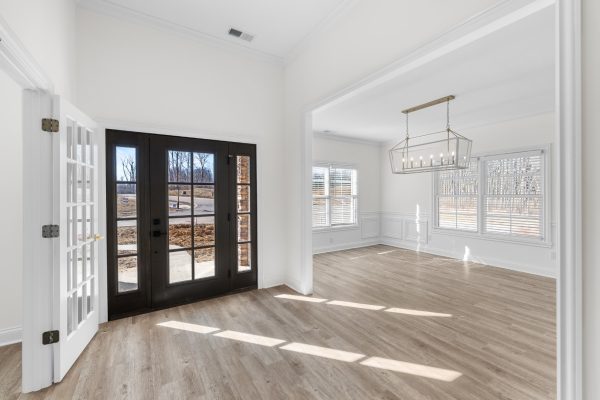
Your Winterization Home Checklist
Winter is here. Protecting your investment is easier than you might think.
Winterizing a property is crucial, whether it’s new construction or an existing home. It generally only takes a weekend or two to get a property in shape and ready for cold weather. Snow, ice, and freezing temperatures may impact a house and yard in unintended ways, resulting in expensive repairs come spring.
Now is the best time to winterize your house. With proper winterization, you can stay cozy and healthy, and even become more energy efficient. Let’s look at seven of the best ways to winterize your house. Use this checklist to make sure that your house is ready for winter.
Check and clean your gutters
Cleaning your gutters is one of the most important things you can do to winterize your house. Why?
When leaves and other debris clog your gutters, it can cause water to pool and freeze. As it freezes, it can create icicles and ice dams. And while icicles and ice dams may look pretty, they can do real damage to you and your house.
Falling icicles can hurt you or cause slippery conditions. Ice dams can allow water to seep behind your walls. That can cause mold in your house, which is a huge health hazard and can be expensive to resolve. Ice dams can also force water to collect around your house’s foundation. This can lead to soil erosion and foundation damage, which is one of the worst fears homeowners have. Fortunately, there’s a solution.
We’ve created a guide with some of the best ways to maintain your gutters. Make sure you clean them out before it gets too cold. Cleaning your gutters should be one of the first things you do to winterize your house.
Set ceiling fans to rotate clockwise
If you have a ceiling fan, setting it to rotate clockwise is a free and easy way to winterize your house. When your fan rotates clockwise, it pushes warm air downward toward the floor. This can keep rooms warmer for longer, which means your heater doesn’t have to work as hard. While this certainly won’t replace your heater, it’s still a good way to winterize your house cost effectively.
Replace your air filters
Your central heating system does more than just heat your house. It also filters out allergens and dander. But when your heater’s filters are dirty, it takes much longer for warm air to spread throughout your house. It also means the air you breathe isn’t as clean as it could be.
If you don’t already have a schedule for filter changes, start keeping one right now. Changing your filters regularly can help your furnace run more efficiently and extend its life. It also keeps the air in your house from going stale and irritating your lungs. Finally, changing your filters is one of the easiest and most highly recommended things technicians recommend you do for your home and health.
Caulk window gaps and consider insulation film
Sometimes, cold air seeps through gaps and cracks in your window frames. An easy way to solve this problem is to reseal cracks with caulk. Re-caulking your windows is a great way to winterize your house and can also carry over to the summer for temperature regulation. Plus, caulking your windows is easy with our helpful guide to window care.
Another easy way to winterize your house’s windows is with insulation film. This film is especially useful for older window panes. Though insulation film won’t fix air leaks in the window frame, it can help keep cold air out of your house if installed properly.
Drain your water heater
All year long, your water heater builds up minerals and sediment from the water it heats. This can force your water heater to work harder to heat your water. The harder it works, the more likely it is to break down. And while 2-10 Home Buyers Warranty (2-10 HBW) can provide coverage for routine water heater breakdowns, it’s much smarter to reduce the likelihood of a breakdown by draining your water heater.
Heat System Check
Before temperatures plummet be sure the have your heating system checked. There could be a part that seems like it could go out. You don’t want that to happen snowed it. When temperatures plummet, systems break and repair companies get backed up. During high repair times it could take weeks to get someone to even look at what went wrong.
We wrote a comprehensive guide for how to drain a water heater’s tank. When you drain your water heater, you flush out all the deposits that have collected in it. This makes it work more efficiently to heat your water and helps prevent expensive breakdowns. Because no one wants a cold shower when they expect hot water, especially in the winter!
Insulate exposed plumbing pipes, check outdoor spiogots and faucets for leaks
Winter can be a nightmare for your plumbing if it lacks insulation. If you have exposed plumbing, especially outside your home, make sure it’s properly insulated. Otherwise, those pipes may burst, which can affect your water supply and your home.
Make sure you also disconnect any hoses from outside fixtures. Water that freezes in hoses connected to outdoor fixtures can cause extensive damage to your indoor pipes. As you disconnect your hoses, check any outdoor faucets for leaks.
If you have questions about how to winterize your home for the coming winter, give us a call. We’re happy to help. And if you’re looking at new homes, we’ll be glad to help with that, too!
Tags: homebuilder owensboro ky, homes for sale owensboro ky, new homes owensboro ky




 Privacy Policy
Privacy Policy